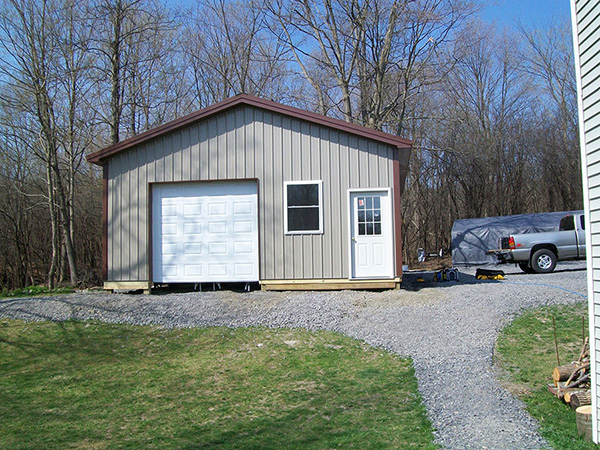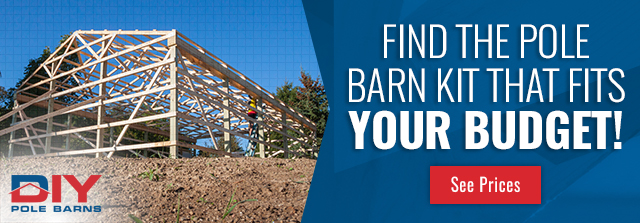Taking care of your pole barn is important to keep it safe for you, your animals or the equipment you store inside. Over time, weathering and age can take their toll on any building. But these things aren’t inevitable. Being proactive with pole barn maintenance will help you keep it in perfect condition for decades to come!
If you’re thinking of building a pole barn for your homestead, read on to learn tips for the most common types of maintenance your pole barn may need.
Importance of Pole Barn Maintenance
Properly maintaining any building is a key part of extending its life. While no building lasts forever, many can span lifetimes with proper care and attention. Our pole barns are built to last – and proper maintenance helps them stay in ideal condition for decades.
Taking good care of a pole barn is a great way to avoid letting small problems turn into big ones, it lets you enjoy your pole barn without worrying about major damage. A tiny leak can easily turn into rotting wood over the years, and that may lead to structural concerns, but these issues are often avoided with simple pole barn maintenance steps that anyone can do!
A well-maintained pole barn is also a huge benefit when you plan to sell your property. Small dings or damage may not bother you but taking care of your property can earn you thousands more when you move away.
Common Pole Barn Maintenance Needs
Watch for Leaks & Repair Them Immediately
One of the most common issues any building deals with is the potential for leaks. It can be difficult to identify them, especially if you aren’t comfortable climbing onto your roof. One good way to find leaks is to patrol the interior of your pole barn during a rainstorm. While it won’t clue you into every leak, it will highlight the most severe ones.
Leaks aren’t inevitable, but they are likely as your barn ages. The expansion and contraction of wood throughout each season, along with the damage sustained from heavy winds and debris can cause small damage that builds over time. Even a small leak can quickly grow into a serious problem.
Mold and air quality issues are a primary concern for leaky barns. Especially if you keep livestock in them, poor air quality can impact their health quickly. Continued exposure to mold can exponentially increase any illness associated with the spores. This isn’t a problem unique to pole barns, either. Even your home is susceptible to leaks – so keep your eye open at all times!
The most important season of the year to prep for leaks is winter. Not only can icy weather exacerbate breaches in your barn, the ice can do major damage to equipment or the integrity of the structure if left unmanaged.
Check Your Pole Barn Siding
While your roof is a major concern for weathering, your siding is also at risk. If you live in an area with high-winds, your barn may experience significant impact damage from branches and other flying debris.
Many homeowners, when planning their pole barn site, will specifically aim to build in an area with enough trees or hills to create a wind break. This can reduce incidental damage to your pole barn siding.
Mowing the grass near your pole barn can also do damage to your siding. Rocks and pebbles kicked up by a mower will hit your siding at high-speed, leaving small dents that add up over time.
One of the best solutions for this is to add a wainscot to your pole barn. Not only does it give your pole barn an improved aesthetic, but it’s also easier to replace than the entire siding if the damage becomes too extreme.
Watch for Pole Barn Rust
Your pole barn is your pride and joy. It’s your home away from home, your man cave, or whichever purpose you designed it. It’s important to make sure that as your pole barn ages, you are able to keep it looking as new as the day it was erected.
Being proactive about pole barn rust is a great way to keep your pole barn looking beautiful. Not only is rust an eye sore, it could also lead to other more serious problems if left to continue. Untreated rust will only grow worse – weakening the metal roofing or siding and potentially leading to issues like leaks.
Pole barns are primarily made of metal, and while your DIY Pole Barn structure is as resistant to rust as we can make it, it’s something you’ll want to keep an eye out for. Rust damage, in a way, is sort of like mold. Quick identification and thorough remediation dramatically reduces its effect on your pole barn. When it comes to pole barn maintenance, an eye for rust is one of the best things you can do to elongate the lifespan of your structure.
Inspect for Termites or Signs of Other Insects
As a pole barn owner, you should always be on the lookout for any signs of termites or insect nests. It’s true, while they may not be as destructive as other pests, they can still be quite a nuisance. Not only are they worth taking care of as soon as you see them, but keeping your barn in good shape all the time can really help prevent them from appearing.
Any building with wood is vulnerable to termites, and insects often choose your comfy new pole barn for their nests to avoid the elements. The best way to prevent this is to make sure you check your barn regularly, keeping it in good condition, and making sure any holes or cracks are repaired.
In the Fall, Keep the Gutters Clear
Not every pole barn will have gutters, but if you live in a region prone to snow and rain, it’s a good idea to include them.
Just like your home, pole barn gutters only need to be checked about twice a year to make sure they are working properly and are not in need of repair. It’s an easy task with big returns!
Functional gutters are critical for avoiding issues related to water backup and intrusion into your barn. Keeping them clear of leaves and debris keeps them healthy and lets the water flow! Without the ability to flow freely and eject away from your pole barn, it will sit there, potentially leading to mold growth and other problems.
For Winter Pole Barn Maintenance, Keep Snow & Debris Off the Roof
Winter can be very harsh on your pole barn. While they’re designed to handle a suitable amount of snow for your region, some winters can bring unusual amounts of snowfall. If you’re experiencing a heavy snow, it’s important to keep an eye on your pole barn to ensure it doesn’t take on more weight than its designed snow load.
The best way to deal with this snow is by removing it from your roof regularly. It can be dangerous, so it’s important to know what you’re doing before you attempt to clear your pole barn’s roof!
A roof rake or similar tool is the easiest way to clear the snow. You may not even need a ladder. If you do have to use a ladder, be very careful. Ice and snow can make any surface slippery – both the ladder itself or the location it’s resting against.
Another reason to deal with snow on your roof is ice dams. Collected snow can block the natural drainage of water, leading to icy build up. Not only can these icicles become dangerous, they can also damage the roof or increase the likelihood of leaks in your barn.
Inspect Your Doors & Windows
Pole barns have a variety of different types of doors and windows. Some have only a primary overhead or sliding door, while others can have several windows and side-entry doors. No matter what type of doors or windows your pole barn has, those moving parts can degrade over time.

One subtle place that you need to focus on is the weather-sealing. Constantly subjected to cold weather and rain, these parts of your barn can suffer the most damage over the years. If they become too degraded, they’ll stop functioning. This means leaks and drafts in your barn.
Drafts can introduce cold into a barn that’s meant for some degree of temperature control. This can damage equipment or put livestock in harm’s way. While many animals like to stay cool, a bad winter can be particularly rough on smaller animals not suited for the cold.
If livestock or equipment isn’t a worry for you, also consider the risks of mold growing from invasive moisture. Once the seal isn’t keeping the rain out, moisture can easily sneak in and begin feeding molds or mildew.
Tips for Easy Pole Barn Maintenance
Check Your Pole Barn Frequently
You never know when a problem can pop up. The number of external factors impacting your pole barn are countless – so treat it with the same care you treat your home or vehicle. You don’t need to do thorough inspections every day, but a quick walkthrough and around the outside can be enough to identify potential damage before it’s serious.
Fix Small Issues Early
It’s far easier to repair small issues when they’re still small. Look at a fraying weather-seal or tiny breach in the wood as a chance to patch up and keep your barn looking new. Taking pride in your pole barn will keep it looking beautiful for years to come, and give you a good feeling every time you use it.
Keep an Eye on the Weather
Bad weather is always a risk to any structure. If you know heavy snow is on its way, consider taking the time to clear existing snow off your pole barn. You should also double-check to make sure that the windows and doors are closed and secure.
Find Your Perfect Pole Barn Today – Get an Instant Quote Online!
Do you have questions about pole barns? Call our knowledgeable staff at (937) 547-9100. If you’re ready to build your pole barn, lock in a quote with DIY Pole Barns using our Instant Quote tool!
Connect with us on social media!




